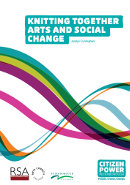
Details
| Title | Knitting Together Arts and Social Change |
| Author | Jocelyn Cunningham |
| Publisher | RSA |
| Published | 2013 |
| Get | Read / watch this |
Related conversations



Related Materials

Recommended by

Knitting Together Arts and Social Change
If we are going to tackle reinventing local services, do we not also need to take seriously the capabilities that lead to imaginative solutions and collaborative behaviour? Is it not critical for us as a society in grave need of re-imagining, not to lose this opportunity and resource? This is not to suggest that our collaborative capacities are entirely dependent upon our imaginative ones, but rather to highlight and re-position the value of the imagination and working in creative ways to create change.
‘A society in which arts practice is not endemic risks its future. The support of professional artists is a laudable policy but far more important is offering all citizens, and their offspring, the opportunity to actively participate in arts practice – to make their own culture’.
There is a remarkable opportunity in these uncertain and financially anxious times for artists to reshape a space for new ways of doing things in the public arena; to bring what is known from creative practice and introduce these approaches to those attempting to find ways of collaborating, innovating, and finding imaginative solutions.
The future needs to be about finding partners (the word partners is used to imply co-creators as opposed to those who fund only) who may seem initially unlikely as playmates but together can generate rich artistic and social outcomes.
Peter Block defines civic engagement as ‘action through which citizens join in new conversations that have the capacity to alter the future’. This interpretation of engagement highlights action, new ways of working and imagining things to be otherwise, all characteristics of working with creative practice. Collaborative creative activity can act as the primary building block for:
• developing connections (especially between those who might not normally engage with each other)
• strengthening a sense of purpose and personal meaning
• encouraging civic engagement and a willingness to change things
As we shift ever more decisively into a knowledge and experienced-based economy, we need to build our capacity for creativity in all walks of life. Rather than divisive arguments that seek funding for one area rather than another, is it not time to seek what advantages we gain by working with our existing innovative assets? The traditional model of arts organisations delivering core programming with public engagement as an outreach mechanism has ‘marginalised the concept of culture and denied theorists and practitioners an extremely effective tool’.15 It has also been divisive in the arts community; those that do socially engaged or participatory practice and those that don’t.
With increasing emphases on public decision-making on significant and far-reaching issues, it is not only imperative to strengthen collaborative working practices between services and sectors but with the public as well. And this necessitates the abilities to work with difference and a capacity for empathy, another distinct outcome in working with creative practice. It is no longer possible to leave engagement to others.
Educational philosophers have articulated the difference between an experience and the quality of that experience and it is strange that there is so little attention as to what a quality engagement experience in the arts looks like or how a high quality of engagement adds value. The quality issue tends to focus only upon the art form product or the numbers reached. It is time to take the process of engagement seriously.
We also need to recognise who is not in the conversation. All too frequently it is the voluntary sector, a vastly underestimated source of learning for the motivations for engagement. Sport England effectively links amateur sport, emerging athletes and elite sport in order to create a ‘sporting habit for life’. An ‘arts habit for life’ would need to take account of all aspects of how the arts influences our lives.
Seeing a place as a cultural ecology requiring a complex range of organisations and individuals contributing to a rich public offer rather than a single agency or two delivering culture is the way forward and evaluating this as part of the whole context of a place with perspectives from all players is now needed.